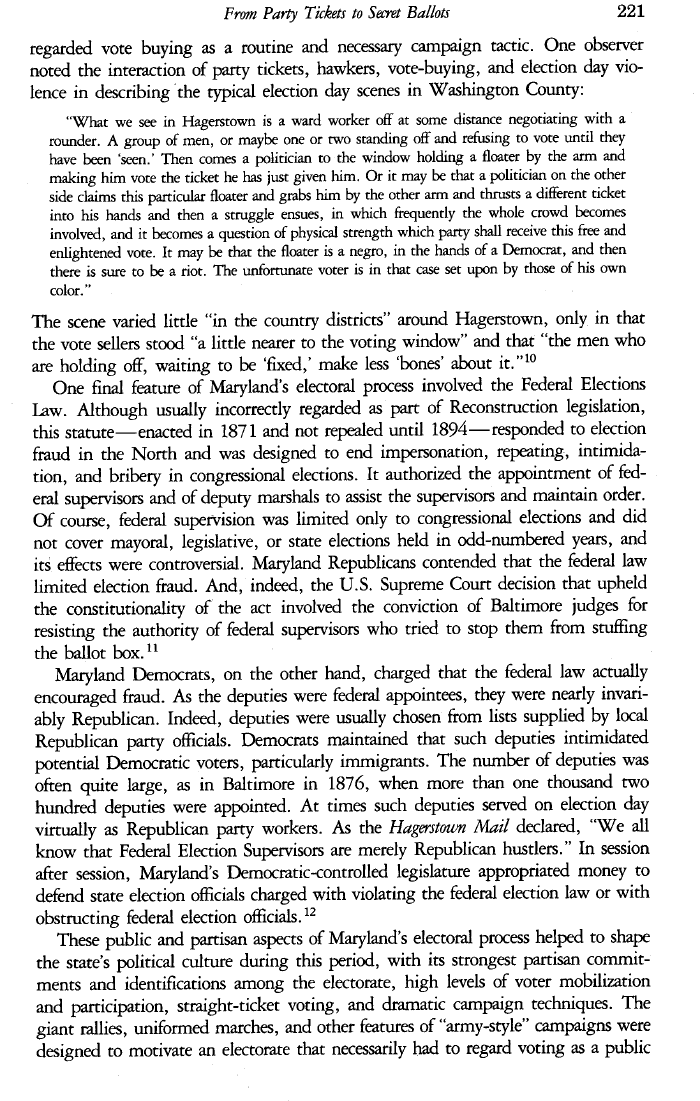|
From Party Tickets to Secret Ballots 221
regarded vote buying as a routine and necessary campaign tactic. One
observer
noted the interaction of party tickets, hawkers, vote-buying, and election
day vio-
lence in describing the typical election day scenes in Washington County:
"What we see in Hagerstown is a ward worker off at some distance
negotiating with a
rounder. A group of men, or maybe one or two standing off and refusing to
vote until they
have been 'seen.' Then comes a politician to the window holding a floater
by the arm and
making him vote the ticket he has just given him. Or it may be that a
politician on the other
side claims this particular floater and grabs him by the other arm and
thrusts a different ticket
into his hands and then a struggle ensues, in which frequently the whole
crowd becomes
involved, and it becomes a question of physical strength which party shall
receive this free and
enlightened vote. It may be that the floater is a negro, in the hands of a
Democrat, and then
there is sure to be a riot. The unfortunate voter is in that case set upon
by those of his own
color."
The scene varied little "in the country districts" around Hagerstown, only
in that
the vote sellers stood "a little nearer to the voting window" and that "the
men who
are holding off, waiting to be `fixed,' make less `bones' about it."lo
One final feature of Maryland's electoral process involved the Federal
Elections
Law. Although usually incorrectly regarded as part of Reconstruction
legislation,
this statute-enacted in 1871 and not repealed until 1894-responded to
election
fraud in the North and was designed to end impersonation, repeating,
intimida-
tion, and bribery in congressional elections. It authorized the appointment
of fed-
eral supervisors and of deputy marshals to assist the supervisors and
maintain order.
Of course, federal supervision was limited only to congressional elections
and did
not cover mayoral, legislative, or state elections held in odd-numbered
years, and
its effects were controversial. Maryland Republicans contended that the
federal law
limited election fraud. And, indeed, the U.S. Supreme Court decision that
upheld
the constitutionality of the act involved the conviction of Baltimore
judges for
resisting the authority of federal supervisors who tried to stop them from
stuffing
the ballot box."
Maryland Democrats, on the other hand, charged that the federal law actually
encouraged fraud. As the deputies were federal appointees, they were nearly
invari-
ably Republican. Indeed, deputies were usually chosen from lists supplied
by local
Republican party officials. Democrats maintained that such deputies
intimidated
potential Democratic voters, particularly immigrants. The number of
deputies was
often quite large, as in Baltimore in 1876, when more than one thousand two
hundred deputies were appointed. At times such deputies served on election
day
virtually as Republican party workers. As the Hagerstoum Mail declared, "We
all
know that Federal Election Supervisors are merely Republican hustlers." In
session
after session, Maryland's Democratic-controlled legislature appropriated
money to
defend state election officials charged with violating the federal election
law or with
obstructing federal election officials."
These public and partisan aspects of Maryland's electoral process helped to
shape
the state's political culture during this period, with its strongest
partisan commit-
ments and identifications among the electorate, high levels of voter
mobilization
and participation, straight-ticket voting, and dramatic campaign
techniques. The
giant rallies, uniformed marches, and other features of "army-style"
campaigns were
designed to motivate an electorate that necessarily had to regard voting as
a public
|

